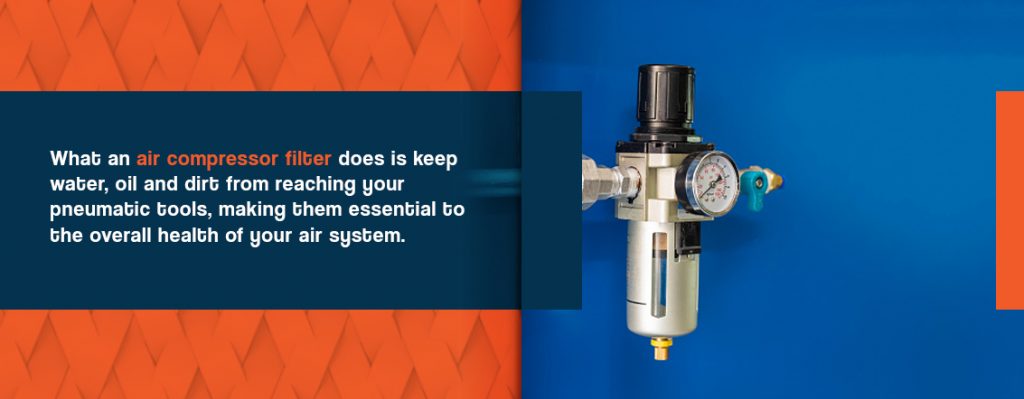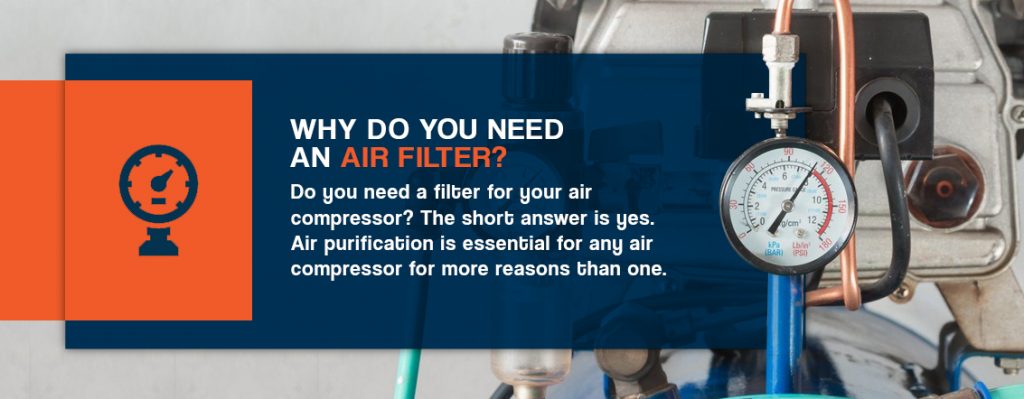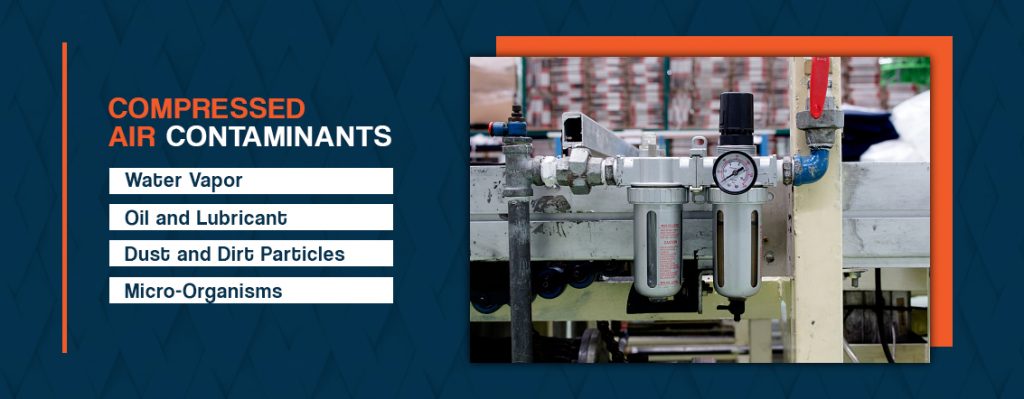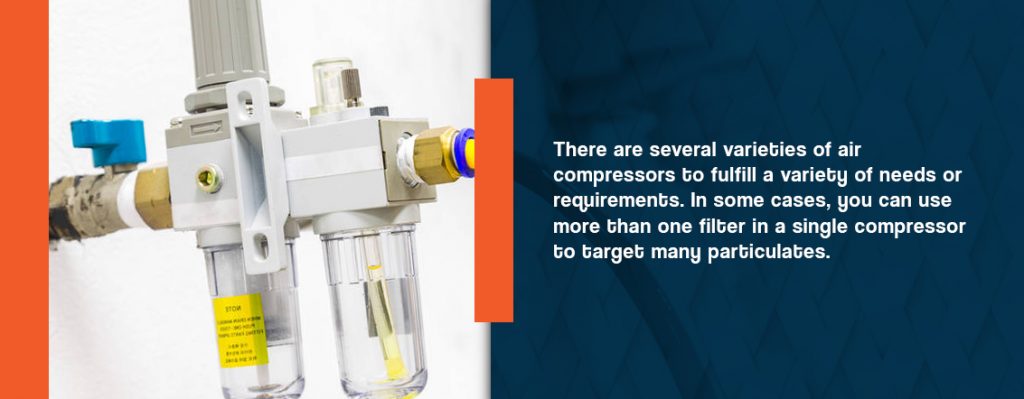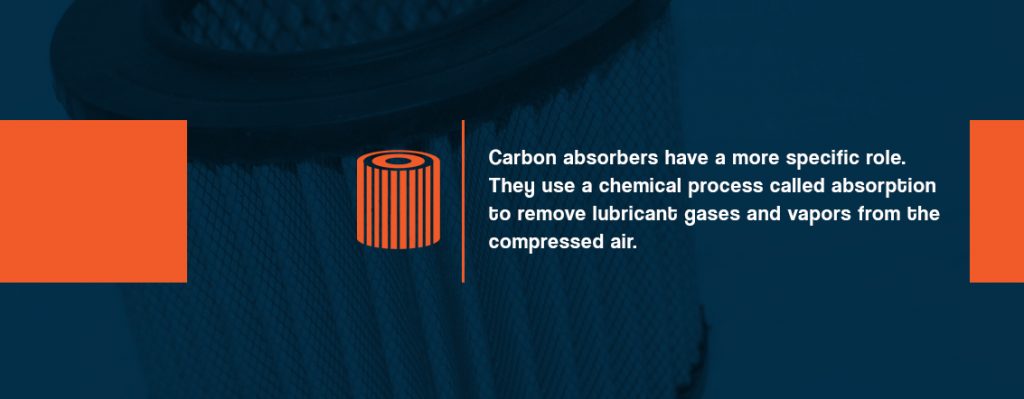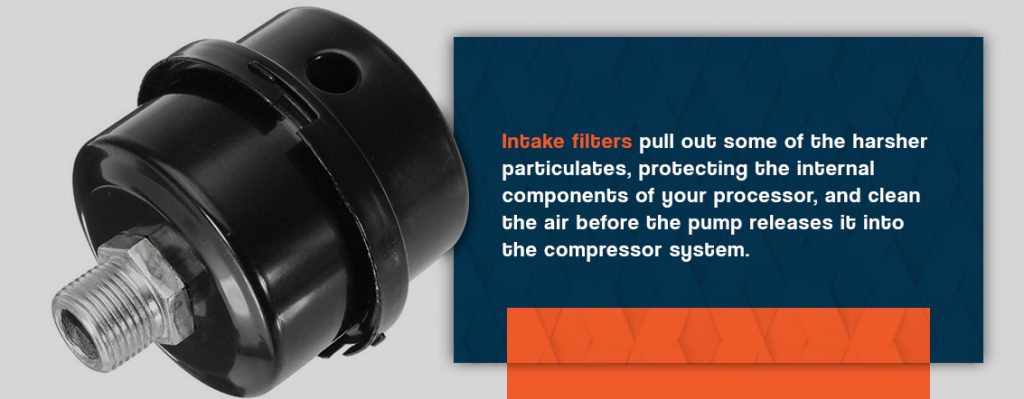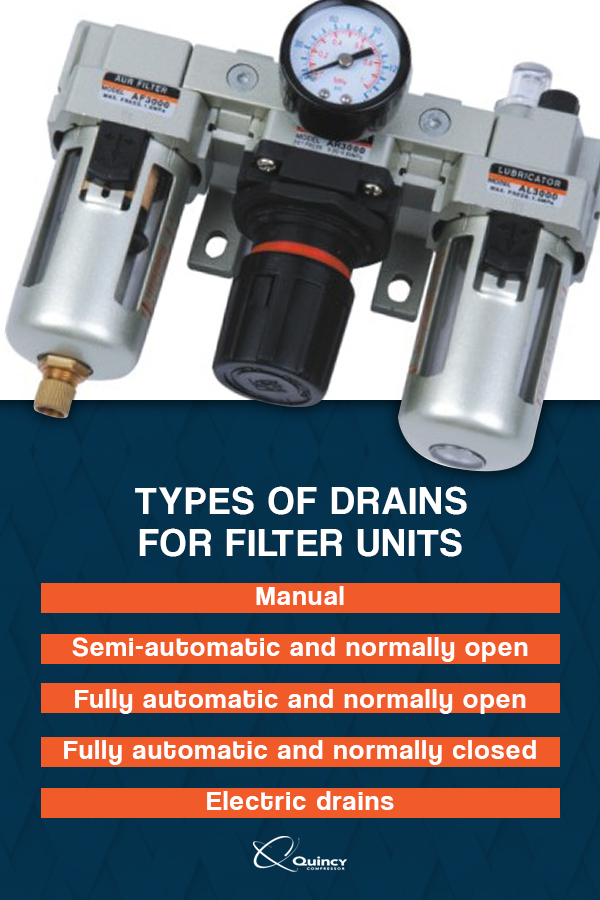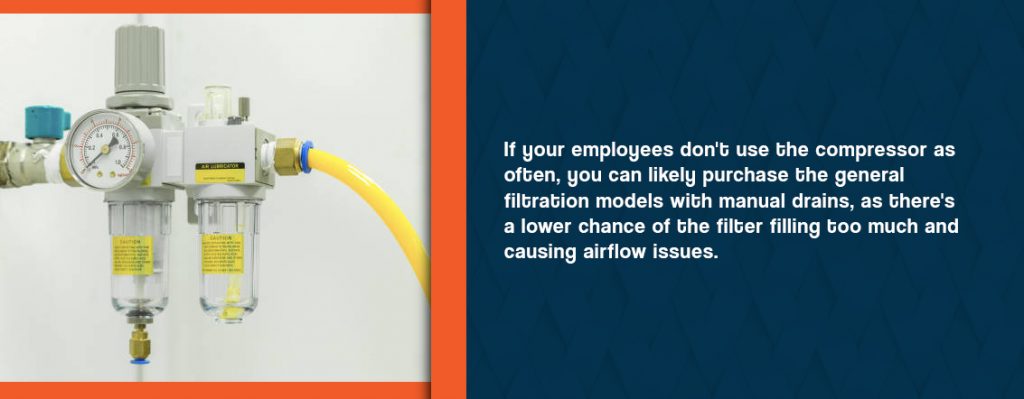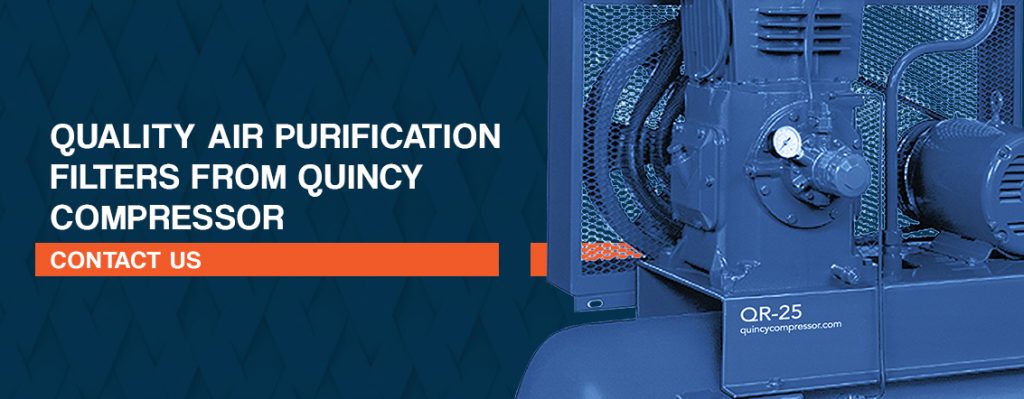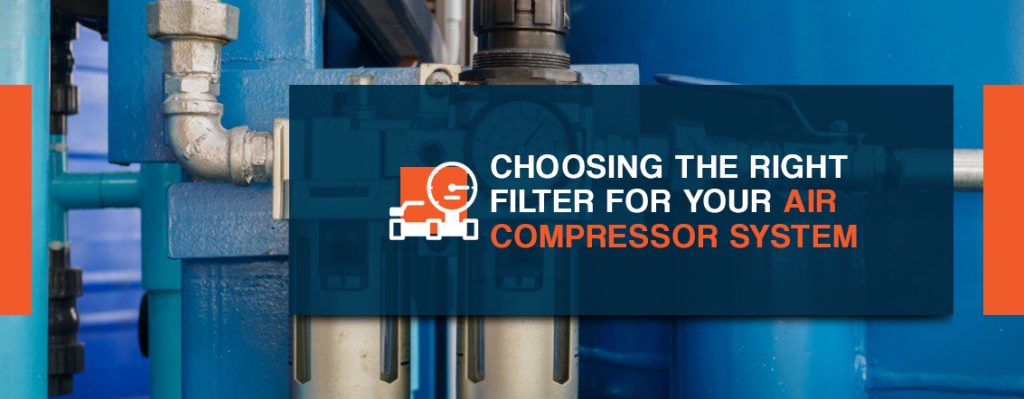
When you’re working with air compressors, air purity and filtration is an essential part of maintenance. Filters play an important role in your industrial air compressor system. Choosing the right filter not only increases the efficiency of your unit, but it can also lower energy costs and protect your employees from harmful chemicals and particulates.
However, not just any air filter will work for your compressor. Depending on the conditions of your workplace, the project you’re completing and how often you use your equipment, you’ll need to make an educated choice. This guide will detail how air compressor filters work, why they’re necessary, what type of air compressor filter to buy and how often you should replace it.
How Does a Compressed Air Filter Work?
Air filters have a relatively standard purpose. As air carrying various particulates and debris passes through them, they trap and collect the particles to purify the air stream. However, different types of filters complete this task in different ways, depending on the kind of particles you need to filter out of the airflow. Some collect wet particles, others target dry particles and some types can even remove vapors and odors.
What an air compressor filter does is keep water, oil and dirt from reaching your pneumatic tools, making them essential to the overall health of your air system. These kinds of debris can damage or destroy your equipment if you don’t provide proper filtration. If they pass through the tools, they can also affect your project negatively, such as by ruining a paint job or contaminating foods in production facilities.
One of the benefits of air filters is that they are relatively inexpensive investments. While you do have to keep up with wear and replace them over time, it costs far less to purchase new filters than to pay for repair costs for damaged pneumatic equipment and compressors. You’ll also have a better overall result in your work, as keeping the air that passes through your compressor clean is essential to tool and equipment health as well as work quality.
Why Do You Need an Air Filter?
Do you need a filter for your air compressor? The short answer is yes. Air purification is essential for any air compressor for more reasons than one. Providing your pneumatic tools with clean air will extend their lifespan significantly as compared to if you don’t use an air compressor filter. Also, without purified air, you won’t be able to guarantee long term use or operational reliability.
When you use a compressor, every cubic foot of air that passes through contains millions of foreign particles, all of which can collect and damage or inhibit your tools. These particles include water droplets, oils, dirt, dust, bacteria and, potentially, pieces of heavy metals, such as lead, mercury and cadmium.
If the air passes through unfiltered, it can cause contamination of the control valves, swell the protective seals and cause premature wear, all potentially leading to equipment failure and a need for repair.
By implementing the proper filtration system for protection and purification, you can reduce machine downtime and overall expenses, as well as limit the amount of necessary maintenance, repair and energy use. But you also need to maintain the filters for the best results, as clogged or worn filters can cause a significant pressure drop, making your compressor less effective.
Depending on your compressor, you may also need to meet OSHA-approved air quality standards and other government regulations. Certain types of filters will help you keep your compressed air compliant.
Compressed Air Contaminants
Depending on how you’re using your air compressor and in what type of environment, there may be various kinds of particles contaminating your air. Most of these are microscopic, but filters can catch large and minuscule particulates. Determining what kinds of contaminants you need to remove from your pressurized air will help you choose the right air compressor filter for your needs.
Water Vapor
Water is naturally occuring in the air as a vapor, and some of it carries into compressed air. With high humidity in workspaces and other gas from the compression process, the particles can potentially cause problems with continued exposure.
In addition to general damage that can result in maintenance expenses and a shortened lifespan, the presence of water vapor can also cause higher rejection rates for plastic injection and spray painting, increased leakage, control system disturbances and corrosion in the pipe system.
Oil and Lubricant
Oil particles are also prevalent in compressed air. However, the amount that passes through depends on the type of machine you’re using, its design, operational age and overall condition.
In relation to compressor design, there are two main categories — those that require lubricant within the compression chamber and those that don’t. Compressors that use lubricant in the compression chamber introduce oil to the compression process and airflow in limited quantities, which can affect the pneumatic tools and job results.
Dust and Dirt Particles
All air contains a small quantity of dirt and dust, but your location can affect what kinds of particles are traveling through your compressor. For instance, if your facilities or jobsites involve working with metals or construction materials, particles from these items can enter the airflow as you’re using the compressor. When allowed to remain in your airflow, these materials can damage pneumatic tools and cause health risks for your employees.
Micro-Organisms
Many of the contaminating particles in compressed air can result in the growth of microorganisms in pipes when they mix with the water and oil residues. Bacteria and viruses can multiply under these conditions, further contaminating the air coming from your pneumatic devices.
However, all of these particulates are removable if you have the proper filters. While wet and dry particles and materials of different sizes require specific types of filters, you can find the right models to suit your needs and install them to purify intake and compressed air.
The Different Types of Air Compressor Filters
There are several varieties of air compressors to fulfill a variety of needs or requirements. In some cases, you can use more than one filter in a single compressor to target many particulates. Each type is applicable as an inline air compressor filter, which attaches to the air output on your tank and catches particulates before they move on to your pneumatic tools.
The model you choose should depend on the materials and compressor you’re working with, what you need to filter out of your air and whether or not you need to meet regulated purification standards. It’s essential to choose the right air compressor filter type, as a proper fit will provide you with the most extended equipment longevity, the best level of air purity and top job quality.
What Is a High Particulate Filter?
Particulate filters are one of the first lines of defense when it comes to air filtration and purification. They remove coarser solid particles from the air, such as dirt, dust, pollen and metallic elements that can cause early wear on tools and ruin projects, as well as burnt oil and bulk liquids.
To begin the filtration process, air passes through a centrifugal separator, which accelerates the contaminants in a spinning or radial motion, pushing them down to collect at the bottom of the unit. Then the air moves on to a filter element, which typically consists of a sintered material, such as bronze or polyethylene. It also acts as protection for the following, more delicate filters.
These kinds of compressor air particulate filters are excellent for compressors used in painting jobs or high amounts of bodywork.
What Is an Activated Carbon Absorber?
Carbon absorbers have a more specific role. They use a chemical process called absorption to remove lubricant gases and vapors from the compressed air. The absorption process uses a particular kind of media filter that allows the vapors to bond and stick, catching them while the air passes through clean.
Typically, these filters use activated carbon from charcoal in the filters, as it provides a broad surface area and naturally attracts oil vapors. They may also include highly porous biochar, which assists with attracting vapor particles.
The chemical makeup of these filters —more specifically, the charcoal and carbon media surface — provides the largest surface area for particle collection with the lowest possible pressure drop. This combination means more absorption and significantly improved air purity.
Since they are so absorbent and target tiny vapor particles, activated carbon absorbers are typically found in OSHA-regulated breathable air systems and compressors. They create a safer work environment for your employees and help you keep your equipment compliant with industry and government regulations when they apply.
As an additional benefit, along with removing the vapors, the charcoal filters also eliminate fumes and odors. Many chemicals carry particularly strong odors and fumes that can affect the health of your workers after long hours of exposure. The carbon traps these, keeping them from escaping your compressor, and creating safer, more breathable air.
If you do choose to install activated carbon absorbers into your compressor system, you should also use a fine particle dust filter after it. As the charcoal filter collects and traps the vapors, allowing clean air to pass through, some of the charcoal particles can break out of the unit and enter the airflow. The following dust filter will remove those particles, providing cleaner air.
While charcoal filters do trap the gaseous lubricants and other chemical vapors that typically flow through compressors uninhibited, they only work for small vapor particles. Despite being called an absorber, these filters aren’t for collecting liquids. If you try to use an absorber without the help of a filter meant to collect and trap liquid, the fluids will oversaturate the carbon filter, wearing it out and requiring replacement in a few hours of use.
What Is a Coalescing Air Filter?
Coalescing filters handle finer particles, typically smaller than a single micron in size. They can remove water, oil, aerosols, paint fluid and other liquids but can’t catch vapors. If you want to remove gases and odors, you’ll need a second activated carbon filter.
Water is extremely harmful and damaging for air compressors and the various related equipment. However, it forms naturally in the machine due to the compression process. Oil particles also come from the equipment’s necessary lubrication. Since these elements are both nearly impossible to avoid, they’re also particularly challenging to filter out of the airflow.
However, the coalescing process makes it possible. First, it collects solids in the filter cartridge. Then, the particles of fluid attach, bringing all the liquid together into larger droplets and, eventually, forming a pool in the filter’s moisture trap. As the droplets get larger, they naturally fall from the filter into the trap where the drain is. This process results in cleaner, dryer air and allows you to drain the pooled fluids automatically or manually.
As the filter runs, it may also collect particulates. If they build up enough without cleaning, they can cause drops in pressure, affecting your airflow.
What Is a Compressor Intake Filter?
The intake area of any compressor is an essential part of air pressure and flow. It draws in air from the surrounding environment through the pump for compression. The intake is the first contact your compressor will have with the air, and the rest of your system relies on its efficiency and ability to pull in air.
To ensure reliable performance, you should have an intake filter. Many models come with one already installed, but some smaller compressors don’t include one. If your compressor doesn’t have one, installing one is essential.
Intake filters pull out some of the harsher particulates, protecting the internal components of your processor, and clean the air before the pump releases it into the compressor system. By doing so, they protect your equipment from dirt and debris, not allowing it to clog anything, stick to the interior elements or inhibit the process in any way. Intake filters also protect your other filters. By providing an initial round of particulate removal, you’ll increase the longevity of your other filters, prevent clogging and provide better air pressure with fewer filter replacements.
Types of Drains for Filter Units
At the bottom of your filter units, there are cup-like areas that collect debris, liquids and other contaminants. Most varieties provide a simple method of cleaning by way of a drain connected to the collection chamber. Depending on your needs, there are several varieties of drain available:
- Manual: Manual drains require you or the operator to empty them once they are full of filtered particulates or liquids. You can accomplish this by twisting the drain plug on the bottom of the filter. Typically, it’s best to empty them on a regular schedule, such as once per shift or after each use.
- Semi-automatic and normally open: There are several types of automatic drains. Semi-automatic and normally open drain types empty as soon as the operator shuts off the compressed air, guaranteeing an emptied filter after each use.
- Fully automatic and normally open: Fully automatic drains empty themselves even more regularly, with the normally open design releasing collected particles as soon as the operator shuts off the compressed air and when the bowl fills to a certain level.
- Fully automatic and normally closed: While this model also empties once the filter bowl fills to a certain level, the normally closed design means it opens as soon as the operator turns on the compressed air, rather than off.
- Electric drains: The electric drain varieties are closer to the manual type, but provide more functional options. They allow you to open and close the drain remotely using electrical signals.
Other Factors to Consider When Buying a Filter
When it comes to purchasing the best filter type for your needs, there are more factors to consider than what particles it will remove from your airflow. It’s essential to make a well-informed choice, as the filtration methods you choose can make a difference in job quality and the longevity and health of your equipment. Several elements contribute to how to choose an inline filter for your air compressor.
Type of Compressor
One of the more significant factors is the type of compressor you’re using. Each variety will have specific requirements and fittings, and if you want the best results, it’s essential to find the most secure and proper fit. There are three main varieties of air compressors — centrifugal, rotary screw and reciprocating.
The centrifugal model is excellent for higher capacity uses, and it functions based on an energy transfer from the rotation of the impeller to the air. They’re oil-free in the compression area, meaning a lower need for filtering out oil vapors.
The rotary screw compressor uses the process of positive displacement, with the most common option being a spiral lobe or single-stage helical oil-flooded screw. It uses two cased rotors to compress the air. They require oil cooling, which may make oil vapor filtering more necessary.
The reciprocating models also use positive displacement methods, as they raise air pressure by lowering its volume. An internal piston helps the machine take in volumes of air and confine it into an enclosed space. These models come in several configurations, such as air-cooled or water-cooled and lubricated or non-lubricated.
To figure out what filter type is best for your compressor model, you can also read the original instruction manual. Typically, it will detail the best fitting filter and how to install it.
Frequency of Use
You should also consider how often you use your compressor and how long you use it for each shift. If you use your compressor more frequently, and for long shifts, you should install a stronger filter with an automatic drain system. That way, your operator won’t have to stop as often to empty the filter.
If your employees don’t use the compressor as often, you can likely purchase the general filtration models with manual drains, as there’s a lower chance of the filter filling too much and causing airflow issues. But if you do install the manual drain variety, your operators will have to empty the filter periodically.
Industry
The industry you’re in may also impact your decision. Depending on the jobs for which your operators use the compressed air equipment, you may need one filter or several. For instance, when it comes to painting and bodywork applications, it’s best to filter out all the particulates possible, as solids and vapors can ruin a paint job. If you need to be careful about employee health, activated carbon filters will help you keep their air free of chemical fumes.
You also need to check whether or not you need to meet any industry or government standards. One of the leading compressed air purity standards is ISO 8573-1:2010, which defines the requirements for air quality. If your company has to consider compliance, you may need to install specific varieties of filters.
When to Replace Your Filters
For filters to work efficiently and provide the best purification possible, they require regular maintenance and replacement. There are general guidelines you can follow, but no specific designated operational period, as your replacement schedule should be tailored depending on several factors.
Your operators should create a routine of checking, draining and replacing filters based on use. If they use the compressors for long periods daily, the maintenance schedule should be more frequent, with daily checks and regular cleanings. It’s also best to line up filter draining and replacements with cleaning the compressor parts and applying oil in areas that need lubrication.
By providing ongoing and thorough maintenance to the compressor and filters, you can prevent premature wear and damage. Your operators will know best when it’s time to replace their filters. Two of the most significant signs are changes in air output and signs of wear or oversaturation. Checking them regularly will help them determine how much longer their filters will last and when it’s time to order a new one.
Quality Air Purification Filters From Quincy Compressor
No matter what job you’re tackling, your compressor should provide the cleanest air possible. With Quincy Compressor, you can find the right filters for your needs. We offer several varieties of filters, including standard and high-pressure models. When you work with us, you’ll benefit from uncompromising reliability, industry-leading warranty programs and 24-hour service support.
Partner with Quincy Compressor for better air purity — browse our products or contact us for more information.


